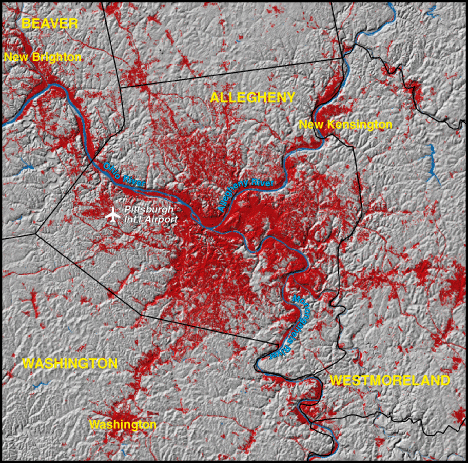Pittsburgh, Pennsylvania 1973


|
1970 Population - 2,401,362
Includes Allegheny, Beaver, Westmoreland, and Washington Counties. NOTE: portions of the above listed counties may not be visible on the map Red areas shown as developed land 212,200 acres (331 square miles) |
Pittsburgh had its start during colonial times as a military outpost established to control parts of the Allegheny, Monongahela, and Ohio Rivers. The city grew as an outfitting center for Ohio Valley settlements, producing items not easily transported across the mountains. An industrial economy grew as access to locally abundant coal and water transportation was exploited. Manufacturing flourished after 1870 as the use of these resources and a culture of industrial entrepreneurialism combined to make Pittsburgh a leader in producing steel, glass, electrical equipment, and processed food. Industry and urbanization spread along major and minor stream valleys within the region. |
Pittsburgh, Pennsylvania 1992

|
1990 Population - 2,097,447
Includes Allegheny, Beaver, Westmoreland, and Washington Counties. NOTE: portions of the above listed counties may not be visible on the map Red areas shown as developed land 249,100 acres (389 square miles) |
The city's reliance on manufacturing became evident in the 1970s, when deindustrialization led to several decades of industrial cutbacks, high unemployment, and out-migration. Pittsburgh's economy later shifted to rely more heavily on university-supported medical and technological centers and on being a site for numerous corporate headquarters, many established during the heyday of manufacturing. Today, Pittsburgh faces many challenges. The Monongahela Valley communities remain economically depressed after heavy industry's departure. The potential of the three rivers for recreation and postindustrial use has yet to be fully realized. Suburban growth nodes in Allegheny County, such as those near the new airport, continue to funnel development away from the city itself. |